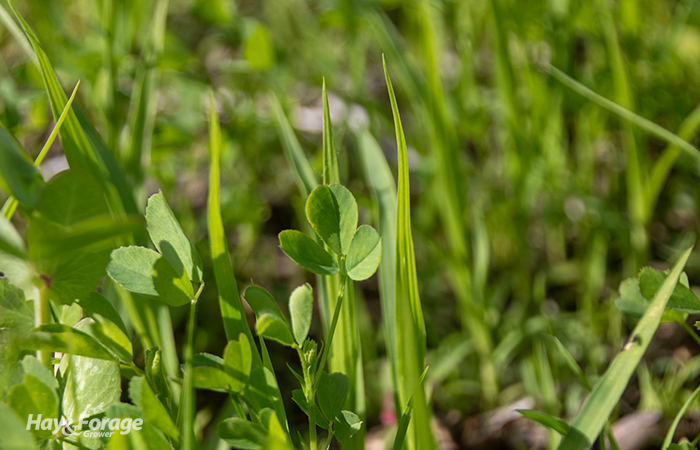Spring-seeded alfalfa do’s and don’ts |
| By Amber Friedrichsen, Managing Editor |
|
|
 Trade-offs already exist between spring seedings and late summer seedings before planting management is added to the mix. The latter time frame often boasts more favorable weather and field conditions for stand establishment. Moreover, weed encroachment and insect pests are less likely to be limiting factors. And late summer seedings are usually ready to harvest right away the subsequent growing season. Spring seedings, on the other hand, are more likely to be delayed by rain or flooded out once seed is in the ground. Spring rains can also cause crusting, which hinders seedling emergence. And excess moisture can put young plants at greater risk of seedling disease, making it all the more crucial to select and plant disease-resistant varieties. Although the short-term forecast may be the biggest instigator of unsuccessful spring seedings, neglecting best practices — or engaging in detrimental ones — could exacerbate a failed attempt at stand establishment. Of course, there is no silver bullet for planting recommendations, but there are a few “do’s” and “don’ts” that resonate across the board. The do’s Do ensure soil pH is between 6.5 to 6.8. Low soil pH can lead to aluminum toxicity, which can be harmful to alfalfa seedlings as it inhibits root growth and the inhabitation of rhizobia bacteria in root nodules. If a lime application is necessary to adjust soil pH, consider postponing a spring seeding to late summer. Better stand establishment and healthier plants could make up for the planting delay in the long run. Do seed alfalfa as soon as possible — but don’t compromise on optimal planting conditions. Yes, an early to mid-April planting can give alfalfa seedlings an advantage over weed growth and help plants get established before the stress of summer weather sets in. However, overlooking the role of soil moisture in planting activities could make the difference between a successful stand and one that barely earns a passing grade. Too dry, and seeds will not imbibe enough water for germination or seedling development; too wet, and field equipment could tear up a nicely prepared seedbed. Do set the drill depth between 1/2- and 3/4-inch, depending on soil texture. Target the deeper end of this range in lighter-textured, sandier soils; reduce the soil depth slightly for heavier soils with higher clay content. After setting the drill depth, check the actual seed depth after making a few passes with the planter, especially where alfalfa is seeded with a no-till drill. Planting too deep is the culprit for many unsuccessful seedings. Do check previous herbicide labels for crop restrictions and residuals to ensure alfalfa can be seeded in a given field. Likewise, follow product labels for postemergence applications to prevent herbicide injury to young seedlings. The don’ts Don’t overwork the ground when using tillage to prepare the seedbed. Tillage can be essential for creating a clean and firm soil foundation, but soil that is too loose will lose moisture more rapidly, which could hurt germination. If deep tillage is necessary, aim to complete this step weeks before stand establishment — and hopefully ahead of some spring rains — so that the soil can settle before seeding alfalfa. It might go without saying, but don’t seed alfalfa after alfalfa. The somewhat mysterious phenomenon of alfalfa autotoxicity causes autoconditioning or autosuppression of seedlings that are interseeded into an existing stand or planted into a recently terminated one. This weakens the root systems of young plants and causes permanent stand damage. In most cases, affected plants will never reach their full potential. In the past, Kim Cassida with Michigan State University has suggested that autotoxicity could be caused by a toxin in mature alfalfa. More recent research has led her team to believe this toxin may be produced and excreted into the soil when plants experience nutrient deficiencies, mainly phosphorus and potassium. However, the mystery continues. Don’t cut spring-seeded alfalfa in the fall if stands are stressed. Leaving forage alone will give it more of an opportunity to store the energy it needs to overwinter, thus supporting better production the following spring. With that said, cutting forage may be warranted to control weeds that have taken over a new stand. A thick mat of annual grass weeds could smother alfalfa out during winter. In this case, use a higher cutting height than normal. A couple of maybes In between the do’s and don’ts of spring-seeded alfalfa is the gray area of “it depends.” For example, seeding a small grain companion crop like oats with alfalfa may enhance total forage yield and serve as weed and erosion control, but doing so could also create competition with young seedlings and hinder first-year alfalfa production. The decision to plant a companion crop could also come down to immediate forage needs. An early season harvest of small grain hay or haylage will bolster supplies, but if extra forage isn’t needed, maybe a companion crop isn’t, either. The best type of seeding equipment for each field also varies. Using a Brillion seeder or drilling alfalfa into a prepared seedbed may be the most effective form of stand establishment. Drills with press wheels can promote seed emergence even further. Conversely, when broadcast seeding, it might be advantageous to up the seeding rate 10% to 15% to account for less seed-to-soil contact when compared to drilling. Use a roller or cultipacker to boost seed-to-soil contact as well. |
